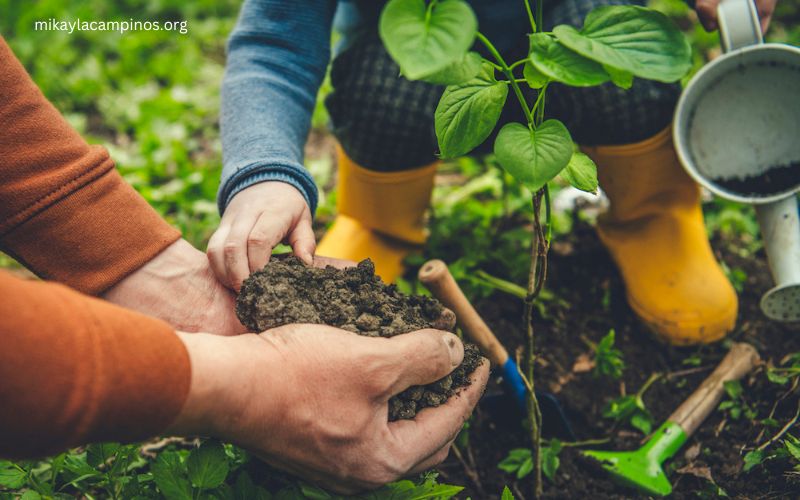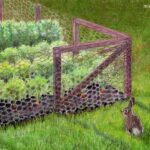Gardening is a rewarding and fulfilling hobby that can provide you with a wide range of benefits, from fresh produce to a beautiful outdoor space. Whether you’re a seasoned green thumb or a complete beginner, this comprehensive guide will walk you through the steps to create and maintain a thriving garden.
In this article, we’ll cover everything from planning your garden layout to harvesting your bounty. By the end, you’ll have the knowledge and confidence to transform your outdoor space into a lush, productive oasis.
Benefits of Gardening
Gardening offers a multitude of benefits that go beyond the physical plants and flowers. Here are just a few reasons why you should consider starting a garden:
- Improved Mental Health: Spending time in nature and engaging in physical activity can help reduce stress, anxiety, and depression. Gardening can be a therapeutic and mindful activity that promotes relaxation and a sense of well-being.
- Increased Physical Activity: Gardening tasks such as digging, planting, and weeding can provide a low-impact workout, helping to improve your overall physical fitness.
- Access to Fresh Produce: Growing your own fruits, vegetables, and herbs allows you to have a steady supply of nutritious, flavorful food right at your fingertips.
- Environmental Benefits: Gardens can help to improve air quality, reduce water runoff, and provide habitat for pollinators and other beneficial insects.
- Sense of Accomplishment: Watching your garden grow and flourish from your own efforts can be incredibly rewarding and give you a sense of pride and achievement.
Planning Your Garden
Before you start digging in the dirt, it’s important to take the time to plan your garden. This will help ensure that you make the most of your available space and choose the right plants for your needs and climate.
Start by considering the following factors:
- Garden Size: Determine the size of your garden based on the available space you have. This will help you decide how many plants you can accommodate and what type of layout will work best.
- Sunlight Exposure: Observe the amount of sunlight your garden location receives throughout the day. Different plants have varying light requirements, so this information will guide your plant selection.
- Soil Conditions: Assess the quality of your soil by conducting a soil test. This will help you understand the pH, nutrient levels, and any amendments that may be needed to create the ideal growing environment.
- Microclimates: Identify any microclimates in your garden, such as shaded areas or wind-exposed spots, as these can impact plant growth and placement.
- Garden Style: Decide on the overall aesthetic you want to achieve, whether it’s a traditional vegetable garden, a vibrant flower bed, or a combination of both.
Once you have a clear vision for your garden, you can start mapping out the layout and selecting the plants that will thrive in your unique growing conditions.
Choosing the Right Location for Your Garden
The location of your garden is crucial for its success. Consider the following factors when selecting the perfect spot:
- Sunlight: Most vegetables, fruits, and many flowering plants require at least 6 hours of direct sunlight per day. Observe the sun’s patterns in your yard to find the sunniest spot.
- Soil Quality: Healthy, nutrient-rich soil is essential for plant growth. Avoid areas with heavy clay or compacted soil, as these can impede root development.
- Drainage: Ensure that the garden location has good drainage to prevent waterlogging, which can lead to root rot and other plant health issues.
- Accessibility: Choose a spot that is easily accessible for tasks like watering, weeding, and harvesting. This will make the maintenance of your garden much easier.
- Protection from Elements: Consider factors like wind, frost, and shade when selecting your garden location. Placement near trees, buildings, or fences can provide valuable protection for your plants.
By carefully evaluating your available space and considering these key factors, you can ensure that your garden thrives in its new home.
Soil Preparation and Testing
Healthy soil is the foundation of a successful garden. Before you start planting, it’s important to prepare and test your soil to ensure it provides the optimal growing conditions for your plants.
- Soil Testing: Conduct a soil test to determine the pH, nutrient levels, and any deficiencies or imbalances in your soil. This information will guide you in making the necessary amendments.
- Soil Amendments: Based on your soil test results, add organic matter such as compost, aged manure, or peat moss to improve soil structure, drainage, and nutrient content.
- Tilling and Mixing: Use a rototiller or garden fork to loosen and mix the soil to a depth of 8-12 inches. This will help incorporate the amendments and create a loose, aerated growing medium.
- pH Adjustment: If your soil test indicates an unsuitable pH level, you can adjust it by adding lime (to increase pH) or sulfur (to decrease pH) according to the recommendations.
- Raised Beds: Consider creating raised garden beds, which can improve drainage, soil quality, and accessibility. Fill the beds with a high-quality potting mix or a blend of topsoil, compost, and other amendments.
By taking the time to properly prepare and test your soil, you’ll be setting your garden up for long-term success and healthier, more productive plants.
Selecting the Right Plants for Your Garden
Choosing the right plants for your garden is crucial for their growth and survival. Consider the following factors when selecting your plants:
- Climate and Hardiness Zones: Research the USDA Hardiness Zones for your region and choose plants that are well-suited to your local climate.
- Sun Exposure: Match your plants’ light requirements (full sun, partial shade, or shade) to the conditions in your garden.
- Mature Size: Ensure that you have enough space for your plants to reach their full size without overcrowding.
- Growing Seasons: Select a variety of plants with different maturity dates to extend your harvest and have a continuous supply of fresh produce.
- Companion Planting: Consider planting certain vegetables, herbs, and flowers together, as they can have beneficial effects on each other’s growth and pest resistance.
- Personal Preferences: Choose plants that you and your family enjoy eating or that fit your desired aesthetic for the garden.
By carefully considering these factors, you can create a thriving, well-balanced garden that meets your needs and preferences.
Starting Seeds or Buying Plants
When it comes to establishing your garden, you have two main options: starting seeds or buying pre-grown plants. Each method has its own advantages and considerations:
Starting Seeds:
- Allows you to grow a wider variety of plants, including unique or heirloom varieties
- Gives you more control over the growing process from the very beginning
- Can be more cost-effective in the long run
- Requires more time and effort, especially for seed starting and seedling care
Buying Plants:
- Provides a head start on the growing season, as you don’t have to wait for seeds to germinate
- Offers a more reliable and predictable outcome, especially for beginner gardeners
- Requires less hands-on work during the early stages of growth
- Can be more expensive, especially for specialty or rare plant varieties
Regardless of which method you choose, be sure to research the specific needs and recommended planting times for each type of plant you intend to grow. This will ensure that your seedlings or purchased plants get off to the best possible start in your garden.
Planting and Spacing Your Garden
Once you’ve selected your plants and prepared your garden bed, it’s time to start planting. Follow these steps for a successful planting process:
- Spacing: Refer to the recommended spacing guidelines for each plant, and use a tape measure or string to mark out the appropriate distances between plants and rows. This will prevent overcrowding and allow for proper growth.
- Depth: Plant seeds and transplants at the recommended depth, usually about 2-3 times the diameter of the seed or root ball.
- Watering: Thoroughly water the soil before and after planting to help the roots establish and settle into their new environment.
- Labeling: Use plant markers or labels to identify each type of plant, especially if you’re growing a variety of crops in your garden.
- Succession Planting: Consider staggering the planting of certain crops, such as lettuce or radishes, to extend your harvest throughout the growing season.
- Crop Rotation: Rotate the location of your plants each year to help prevent the buildup of pests and diseases in the soil.
By following these best practices for planting and spacing, you’ll set your garden up for optimal growth and productivity.
Watering and Fertilizing Your Garden
Proper watering and fertilization are essential for the health and productivity of your garden. Follow these guidelines to ensure your plants receive the necessary resources:
Watering:
- Aim to keep the soil consistently moist, but not waterlogged.
- Water in the morning or evening to minimize evaporation.
- Use a soaker hose or drip irrigation system to deliver water directly to the root zone.
- Adjust watering frequency based on factors like weather, plant type, and soil moisture.
Fertilizing:
- Apply a balanced, slow-release organic fertilizer at the recommended rate and timing for your specific plants.
- Consider using compost tea or liquid fertilizers to provide a quick nutrient boost during the growing season.
- Avoid over-fertilizing, as this can lead to excessive foliage growth and decreased fruit or vegetable production.
- Adjust your fertilizer regimen based on the results of your soil test.
By following these best practices for watering and fertilizing, you’ll ensure your plants have the resources they need to thrive and produce an abundant harvest.
Mulching and Weed Control
Mulching and weed control are essential for maintaining a healthy, productive garden. Here’s how to approach these important tasks:
Mulching:
- Apply a 2-4 inch layer of organic mulch, such as wood chips, shredded bark, or straw, around your plants.
- Mulch helps retain soil moisture, suppress weed growth, and insulate the soil from temperature fluctuations.
- Replenish the mulch layer as needed throughout the growing season.
Weed Control:
- Regularly remove weeds by hand, ensuring you get the entire root system.
- Consider using a hoe or cultivator to cut down weeds at the soil surface.
- Apply a thick layer of mulch to prevent weed seeds from germinating.
- Use landscape fabric or other physical barriers to block weed growth.
- Avoid using chemical herbicides, as they can harm your desired plants and the surrounding ecosystem.
By implementing a comprehensive mulching and weed control strategy, you’ll create an optimal growing environment for your plants and minimize the time and effort required for ongoing garden maintenance.
Garden Maintenance and Pest Control
Maintaining a healthy and thriving garden requires ongoing attention and care. Here are some essential tasks to keep your garden in top shape:
Garden Maintenance:
- Prune and trim plants as needed to encourage proper growth and shape.
- Remove dead or diseased plant material to prevent the spread of problems.
- Monitor your plants regularly for signs of pests or diseases, and address issues promptly.
- Keep your garden free of debris and weeds to maintain a neat and organized appearance.
Pest Control:
- Identify the specific pests affecting your plants and choose appropriate, eco-friendly control methods.
- Use physical barriers, such as row covers or insect netting, to prevent pests from accessing your plants.
- Encourage the presence of beneficial insects, like ladybugs and lacewings, that prey on common garden pests.
- Consider using organic pest control products, such as neem oil or diatomaceous earth, as a last resort.
By staying on top of garden maintenance and implementing sustainable pest control strategies, you’ll ensure the long-term health and productivity of your garden.
Harvesting and Enjoying Your Garden
The culmination of all your hard work is the harvest! Here’s how to make the most of your garden’s bounty:
Harvesting:
- Monitor your plants closely and harvest crops at their peak ripeness for maximum flavor and nutrition.
- Use clean, sharp tools to gently remove fruits, vegetables, and herbs from the plant.
- Handle harvested produce with care to avoid bruising or damage.
Storing and Preserving:
- Store freshly harvested produce properly to extend its shelf life.
- Consider freezing, canning, or drying excess produce to enjoy throughout the year.
- Explore creative ways to incorporate your garden’s harvest into your meals, such as making sauces, jams, or dehydrated snacks.
Sharing and Enjoying:
- Share your garden’s bounty with friends, family, and neighbors.
- Participate in local farmers’ markets or community supported agriculture (CSA) programs to sell or trade your excess produce.
- Take time to savor the flavors of your homegrown fruits, vegetables, and herbs, and appreciate the sense of accomplishment that comes with growing your own food.
By carefully harvesting, storing, and enjoying the fruits of your labor, you’ll be able to maximize the benefits of your garden and create lasting memories.
Troubleshooting Common Gardening Problems
Even the most experienced gardeners encounter challenges from time to time. Here are some common problems and how to address them:
- Poor Plant Growth: If your plants are not thriving, consider factors like soil quality, sunlight exposure, watering, and nutrient deficiencies.
- Pests and Diseases: Identify the specific pest or disease affecting your plants and implement appropriate, eco-friendly control measures.
- Weeds: Maintain a consistent weed-removal schedule and use mulch to suppress weed growth.
- Extreme Weather Conditions: Protect your plants from frost, heat, or heavy rain by using row covers, shade cloths, or other physical barriers.
- Nutrient Deficiencies: Conduct a soil test and amend the soil with the necessary nutrients based on the results.
- Overwatering or Underwatering: Monitor soil moisture levels and adjust your watering schedule accordingly.
- Lack of Pollination: Encourage the presence of pollinators, such as bees and butterflies, by planting a diverse array of flowering plants.
By staying vigilant and addressing issues promptly, you can overcome common gardening challenges and ensure the continued health and productivity of your garden.
Conclusion
Gardening is a rewarding and fulfilling hobby that offers a wide range of benefits, from fresh produce to improved mental and physical well-being. By following the steps outlined in this comprehensive guide, you’ll be well on your way to creating a thriving garden that meets your unique needs and preferences.
Remember, gardening is a continuous learning process, and each season will bring new challenges and opportunities. Embrace the journey, experiment with different techniques, and don’t be afraid to ask for advice from experienced gardeners in your community. With dedication and a bit of patience, you’ll be harvesting the bounty of your own garden in no time.
Ready to start your own garden? Download our free garden planning guide to get started. This comprehensive resource will walk you through every step of the process, from choosing the right location to selecting the perfect plants for your space. Get your copy today and take the first steps towards a bountiful and beautiful garden!



